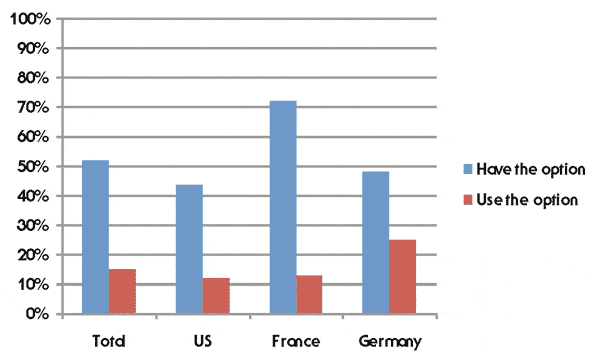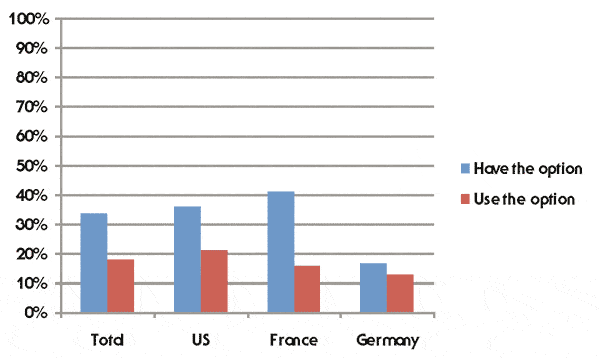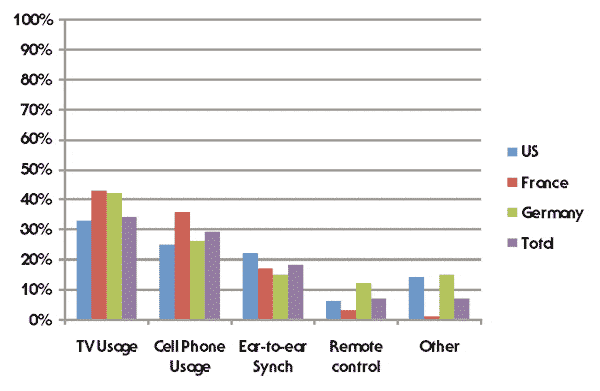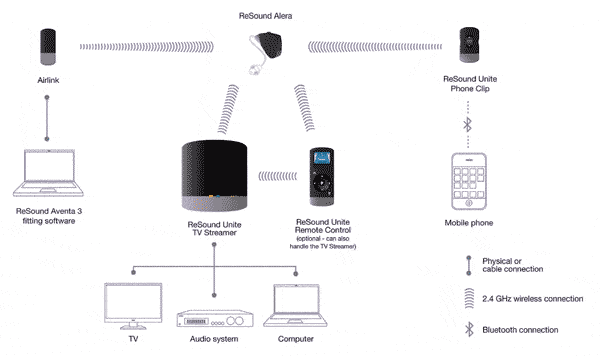Digital wireless features in hearing instruments can potentially increase hearing instrument utility—a key factor in high customer satisfaction. Although this potential is recognized by both end users and hearing care professionals, barriers to the widespread use of wireless systems are often related to the perceived complexity of the systems. A stable and clear-sounding connectivity to TV and cell phones is viewed as the most desired by end users.
Hearing instrument manufacturers continually search for ideas for new products or ways to improve existing ones. For decades, the technological advances that drove hearing instrument development coincided with tangible, self-evident, end-user benefits. Moving from carbon microphone circuitry to vacuum-tube hearing aids broadened the frequency response and reduced distortion. The invention of the transistor led to smaller, less power-hungry devices. Continued progress in the development of transducers, integrated circuits, batteries, and other components, as well as improved manufacturing techniques, resulted in ongoing concrete improvements in size, sound, and utility of hearing instruments. When hearing instruments went digital, a door was opened to a host of new possibilities in sound processing: environmentally steered directional processing became de rigueur, and the emergence of open-fit hearing instruments piggy-backed on advanced feedback cancellation algorithms.

|
This article was submitted to HR by Jennifer Groth, MA, director of audiology communication at the ReSound Audiology Center in Glenview, Ill, and Frederik Anthonsen, MA, a researcher at ReSound headquarters in Ballerup, Denmark. Correspondence can be addressed to HR or Jennifer Groth, MA, at . |
The available technologies of the 21st century could lead hearing instrument developers down many different paths—not all of them equally meaningful for end users. In fact, it can be challenging to keep in mind the purpose of hearing instruments as one gets caught up in the many things hearing instruments can do: “Wouldn’t it be cool if your hearing aid reminded you of appointments/closed your garage door/automatically turned your TV on when it’s time for your favorite show?” While indeed such things might be cool and even somewhat beneficial, it is equally likely that they could culminate in a white elephant of a product that serves no one’s needs adequately. For this reason, it is increasingly important to consult with hearing instrument users and hearing care professionals in order to make relevant design choices.
People-centered product design. One way to learn about the needs, expectations, and priorities of consumers is by conducting market research. Although large-scale market surveys, such as MarkeTrak,1 are invaluable resources for the hearing instrument industry, they identify overall trends and relationships rather than answering the specific questions manufacturers have about hearing instrument features and functionality. Such questions can be as seemingly banal as whether to use a push-button or toggle control for changing programs on a device, but can be important for the ultimate success and efficacy of the product.
Hearing instruments with wireless features such as changing volume on both ears, or streaming audio from a television or cell phone to the hearing instruments, have been commercially available for several years. These types of wireless features differ from the well-established telecoil and FM technologies in that they are based on digital wireless transmission rather than analog. As with digital hearing instruments, digital wireless technology offers greater opportunities for signal processing. Immediate advantages compared to analog wireless transmission include the possibility to provide the audio signal in stereo, less susceptibility to signal interference, better signal-to-noise ratio (SNR), and the possibility of encoding for privacy.
While MarkeTrak surveys have identified issues and desired improvements that theoretically could be addressed via wireless features, it is not clear to what degree user needs and expectations are actually being met in this way. Because ReSound continuously strives to increase value to the consumer, market research specifically targeting wireless features in hearing instruments was carried out. The overall objective of the research was to create a comprehensive understanding of trends and preferences for wireless hearing instruments in the market today among hearing aid users, as well as hearing care professionals. Results of this study have been used in guiding and refining the development of a new product in which wireless technology is available.
Research Methods
The research project included both exploratory and quantitative phases. An explorative stage, based on focus groups and in-depth interviews with clinicians and hearing instrument users, delved into attitudes, expectations, and experiences with wireless hearing instrument features. This information served as input to the design of a large-scale survey to quantify how issues surrounding wireless hearing instrument features are generally viewed by hearing care professionals and end users.
Explorative research. The explorative phase comprised 19 in-depth interviews with hearing care professionals, as well as three focus groups with hearing instrument users. To avoid geographical bias, the interviews and focus groups were conducted in the United States, France, and Germany. The hearing care professionals who participated were randomly selected and interviewed by an independent market research firm. The focus groups were also led by an independent firm, and participants included both users of hearing instruments with wireless features, as well as users of hearing instruments without wireless features.
The overall finding from the focus groups with hearing instrument users was that advantages were seen in terms of connecting to audio sources, such as TV and cell phones, thereby improving ability to hear these devices. Focus group participants expressed concern about ease of use and whether such features might cause them new problems. For example, one participant asked, “If my wife is talking, will I be able to hear her or can I only hear the TV?” Although there was no consensus on demographics of appropriate users of hearing instruments with such features, participants did agree that individuals with active lifestyles who willingly embrace new gadgets and technologies were the most suitable candidates.

FIGURE 1. Percentage of wireless accessories dispensed with hearing instruments with wireless features.

FIGURE 2. Percentage of wireless hearing instrument end users who reported being aware of and using a connectivity to TV feature.

FIGURE 3. Percentage of wireless hearing instrument end users who reported being aware of and using a connectivity to cell phone feature.
Interview results with the hearing care professionals mirrored the focus group results to some extent; connectivity to external audio sources, such as TV and cell phones, was viewed as the most important aspect of wireless. They also agreed with the focus groups that the best candidates were tech-savvy people with active lifestyles, although they regarded age as a factor as well: “The target group is 40 to 60 years old, in the workforce, and are heavy users of their cell phones both in their professional and personal lives” was one representative comment.
Hearing care professionals were also asked about wireless synchronization of hearing instrument settings, and there were two camps on this issue. While some regarded this as very important, others did not think that it offered any benefit for users: “I don’t think that it helps the quality of hearing,” said one participant.
Finally, wireless fitting did not generate much excitement among the interviewees. While some did point out an advantage of not having to use programming cables, others envisioned an even more cumbersome process than what they currently were accustomed to.
Quantitative research. For the quantitative study, specific questionnaires for hearing care professionals and end users were prepared, and an independent market research agency acquired the data. Hearing care professionals were randomly selected and interviewed by telephone. Participants were screened to ensure relevant knowledge and experience with hearing instruments with wireless features. A total of 454 interviews were conducted in the United States, France, and Germany.
Data gathering among end users wearing hearing aids with wireless features was done through panels in the three countries. To ensure that the participants were users of hearing aids with wireless features, potential interviewees were screened according to the following criteria:
- Currently wear hearing aid(s) that are no older than 4 years
- The hearing aids have one or more of the following three features: can connect to cell phone; can transmit TV sound; and/or can change volume or program on both devices by using the controls on only one.
A total of 239 interviews with individuals wearing hearing instruments with wireless features were completed in the three countries. The breakdown of participants is shown in Table 1.

TABLE 1. Interview subjects by country for the quantitative research study, with dispensing professionals on top and hearing aid users on bottom.
Research Results
Users’ perspective. As suggested by the explorative research, there was a trend for fewer individuals to be fit with hearing instruments with wireless features with increasing age. The percentage of individuals over 75 years of age fit with this type of device was half of that reported for those less than 60 years of age.
Figure 1 shows the percentages reported for sales of accessories to hearing instruments with wireless features. Remote controls are the most frequently dispensed accessories, reportedly being sold in 39% of wireless hearing instrument fittings. Other types of accessories accompany hearing instruments with wireless features even less frequently. Judging from this information, it would appear that these hearing instruments are not being dispensed primarily for their wireless capabilities.
These results are also interesting in light of the end users’ reports of their utilization of wireless features, as shown in Figures 2 and 3. In total, about half were aware of having a TV connectivity feature, and about one-third knew that they had a cell phone connectivity feature with the hearing instruments. In both instances, only half or less than half of the individuals who were aware of this functionality reported actually using it.
Of those who do actually make use of such features, satisfaction with them was high. However, 25% to 30% reported experiencing problems with reliability of connections and sound clarity or sound quality.
Professionals’ perspective. The hearing care professionals’ rankings of desired improvements are shown in Figure 4. In each of the three markets and overall, improved solutions for connectivity to TV and to cell phones ranked highest, followed by improvements to ear-to-ear synchronization functionality. Improvements to remote controls and other types of wireless functions were ranked lowest. About two in five (41%) of all of the hearing care professionals interviewed reported using the wireless fitting capability for fitting hearing instruments with wireless features at least 75% of the time. The reason given most often by those who did not regularly use wireless fitting was mainly that it was not the standard of practice at their clinic.

FIGURE 4. Hearing care professionals’ rankings of the most desired improvements in hearing instruments with wireless features.
The improvements most desired regarding wireless fitting were to not have an intermediate device worn by the client (63% of respondents), while others desired a stable connection to the hearing instruments when programming (60% of respondents).
The results of this study suggest that the most important concerns, as expressed by those who fit and use hearing instruments with wireless features, is that solutions are simple, that they provide connectivity in particular to TV and cell phones, that wireless connections are reliable, and that good sound quality is provided.
What implications do these concerns have for the technology selected for hearing instrument applications?
Simplicity: Overcoming the Perception of Complex Equipment
New technologies are often first adopted by younger population segments. In addition, older adults who were not exposed to the particular technology prior to adulthood tend to have a more functional view of it and limited interest in emerging applications. For example, according to a 2007 market research report from comScore, users of cell phones over the age of 35 are less aware of and less interested in connecting to the Internet via cell phones than younger cell phone users.
In the current study, both the explorative and quantitative research results suggest that perception of the digital wireless technology is a barrier to widespread use among hearing instrument users, most of whom are older adults. Yet the wireless features currently available are mostly functional solutions that can improve utility of hearing instruments in specific situations. MarkeTrak research indicates that improved utility in multiple listening environments contributes to higher satisfaction with hearing instruments.2 Thus, it seems reasonable to conclude that, while wireless features for hearing instruments potentially offer better hearing in important situations, the solutions must be very simple to overcome both users’ own and hearing care professionals’ skepticism.
Existing wireless hearing instrument solutions build on near-field magnetic induction (NFMI), which has an extremely limited range of connectivity—so limited, in fact, that wearers of current wireless hearing instruments must also wear a gateway device to receive sounds from any sources beyond 3 feet, then relay them to the hearing instruments. This adds complexity and inconvenience to the system and its functionality for the user. In a review of emerging technologies for wireless connectivity, Bloom3 called for direct transmission to hearing aids from audio sources, and she further predicted that overcoming the obstacle of an inconvenient gateway device would represent a breakthrough for the industry and for users. For this reason, ReSound has chosen to base its wireless technology on a proprietary 2.4 GHz radio, which was selected for its ability to provide strong connections over a range of more than 20 feet.
Bluetooth wireless technology is also based on 2.4 GHz, and has been anticipated to make an appearance in hearing instruments for years. However, this technology is not an optimum choice for hearing instruments. Bluetooth was designed for diversity of applications and must therefore accommodate connections to devices ranging from headsets to printers to audiological equipment. This requires a complicated wireless protocol. The more complicated the protocol, the more power-hungry the chip will be. Furthermore, Bluetooth transmits with greater output power in order to have a range exceeding 30 feet, which also adds to the power consumption. The 2.4 GHz technology chosen by ReSound for implementation in hearing instruments is a point-specific design, meaning that it is optimized for this particular application with a leaner wireless protocol than required by Bluetooth.
The ReSound Alera™ is the first hearing instrument to implement wireless features based on 2.4 GHz. Stable wireless communication directly to the hearing instruments can occur without the use of intermediate devices to make the signal available to the hearing instrument.
The wireless connections that can be made with the Alera hearing instruments are illustrated in Figure 5. The ReSound Unite™ accessories, which wirelessly interface with the hearing instruments, include:
- Airlink™ for wireless fitting;
- Unite™ TV Streamer for use with televisions, radios, stereos, PCs, or any other equipment with audio output;
- Unite™ Phone Clip for use with Bluetooth-enabled mobile phones; and
- Unite™ Remote Control for easy management of the hearing instruments and accessories.

FIGURE 5. ReSound Alera™ wireless network.
Unencumbered Fitting
The first experience a hearing instrument wearer usually has with the new devices is that they are plugged into cables and secured to a desktop programming interface. Not only is this an unnatural and somewhat intimidating situation, the cables themselves can interfere with the fitting.
First and foremost, cables can fall out or be pulled out during the fitting. The client is effectively tethered in place by the cables, precluding moving around or going outside the fitting room to evaluate the sound of the hearing aids in other surroundings. The ReSound Alera™ can be fit wirelessly via the Airlink™, a device similar in size and appearance to a jump drive that plugs into the USB port of the fitting computer. Neither cables nor intermediate devices are required, as the range for communication between the Airlink™ and the hearing instruments extends to at least 10 feet. Unlike wireless fitting based on NFMI, an intermediate device around the patient’s neck is unnecessary.
Robust and Clear Connections to TV and Cell Phones
As revealed by the market research reported here, enhancing the television viewing situation was rated as the most desired improvement in terms of wireless capabilities. Disagreement over the television volume setting can be problematic even in families where no one has hearing loss, so it is no surprise that this is a contentious issue among families with one or more hearing-impaired members.
Apart from the simplicity of streaming audio directly to the hearing instruments, the wireless technology selected for the ReSound solution minimizes the delay of the transmission. The delay in transmission of the sound from the TV streamer to the hearing instruments is critical for sound quality, particularly if the microphones are active or if the user can otherwise hear the direct sound from the television or audio source such as in an open fitting. The delay in the streamed sound to the ReSound Alera™ is 18 ms, which is the lowest of current technologies in hearing instruments. Delays exceeding 25 to 30 ms can be perceived as clear echoes when direct sound also is audible to the wearer.
Not only is the delay between the TV streamer and the hearing instruments well below this, it is also in a range that actually can be beneficial for the wearer in terms of speech recognition. An echo occurring below 30 ms that is similar in level to the direct sound is integrated by the auditory system consistent with combining the two signal powers.4-6
Delay is also critical for audiovisual synchronization. Disturbing “lip synch” issues occur when the difference between the audio and visual signals reaches 80 ms.7 Delay of the streamed sound from the source to the hearing instruments ranges from 35 ms to more than 120 ms for other devices currently available. In addition to the short transmission range and the inconvenience of wearing an intermediate device, the poorer sound quality and degraded audiovisual integration can lead to user dissatisfaction.
Cell phone connectivity was the second most desired improvement in terms of wireless features revealed by the market research. Phone conversations are more difficult than face-to-face conversations regardless of whether or not one has a hearing loss. Visual cues to speech are not available in phone conversations. Additionally, the transmission frequency bandwidth for the telephone is limited to the range of 300-3000 Hz, eliminating useful acoustic information for identification of fricative sounds. Additional variables such as quality of the connection, the individual telephone, and noise in both the speaker’s and the listener’s environment can make hearing on the phone even more challenging.
Even individuals with relatively mild hearing losses may experience great difficulty in using both landline and cell phones. For hearing instrument users, acoustic feedback with any phone and radio interference with the hearing instruments from cell phones can add to the frustration. Anticipated problems using the phone are also an obstacle to not acquiring hearing instruments.8
The ReSound Unite™ Phone Clip is a tiny device that clips onto clothing or a car visor and functions like a Bluetooth headset. When paired with a Bluetooth-compatible cell phone, the user can answer and speak on the phone, as well as turn the volume up and down, even if the phone is in a pocket or handbag.
The Unite Phone Clip streams the sound to both hearing instruments—a critical advantage in improving hearing on the phone. Speech recognition by hearing-impaired individuals has been shown to improve markedly when listening binaurally versus monaurally.9
Summary
Digital wireless features in hearing instruments can potentially increase hearing instrument utility. Market research suggests that, while this potential is recognized by both end users and hearing care professionals, barriers to widespread use are related to the perceived complexity of current solutions.
Stable and clear-sounding connectivity to TV and cell phones is viewed as the most desired improvement to currently available products. ReSound’s wireless platform technology based on 2.4 GHz transmission provides the foundation to meet these market requirements.
References
- Kochkin S. MarkeTrak VIII: 25-year trends in the hearing health market. Hearing Review. 2009;16(11):12-31.
- Kochkin S. Increasing hearing aid adoption through multiple environmental listening utility. Hear Jour. 2007;60(11):28-31.
- Bloom S. Connectivity: early steps point the way toward wireless wonders to come. Hear Jour. 2009;62(10):17-20.
- Haas H. The influence of a single echo on the audibility of speech. J Audio Eng Soc. 1972;20:146-159.
- Lochner JPA, Berger JF. The influence of reflections on auditorium acoustics. J Sound Vibrations. 1964;1:426-454.
- Nabelek AK, Robinette L. Influence of the precedence effect on word identification by normally hearing and hearing-impaired subjects. J Acoust Soc Am. 1978;63:187-194.
- Summerfield Q. Lipreading and audio-visual speech perception. Philos Trans R Soc Lond B Biol Sci. 1992;335:71–78.
- Kochkin S. MarkeTrak VII: Obstacles to adult non-user adoption of hearing aids. Hear Jour. 207;60(4):24-51.
- Nabelek AK, Pickett JK. Monaural and binaural speech perception through hearing aids under noise and reverberation with normal and hearing-impaired listeners. J Sp Hear Res. 1974;17:724-739.
Citation for this article:
Groth J, Anthonsen F. Fewer wires, less complexity, and more connections: The new challenge for wireless hearing instruments. Hearing Review. 2010;17(6):28-36.




.gif)
